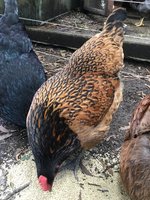- Thread starter
- #11
Tiana's chickens
Songster
- Dec 7, 2017
- 947
- 1,057
- 242
This was him a few weeks earlier


Follow along with the video below to see how to install our site as a web app on your home screen.
Note: This feature may not be available in some browsers.
Thank you so much! Lots for me to think aboutI'm not an expert on feather coloing...I'm just working on understanding it better and have a few basics down.
I can tell you that you will need to wait for his adult feathers to grow in and even through the first adult molt. Roosters don't come into full, true colors until after their first adult molt. Breeders know not to cull or breed until then.
As to his coloring...he leans most to the Blue Laced Red in that his main body is red and he has the blue tail. (Gold laced is black lacing on gold body, which is different than red)
What has happened is that the lacing is not blue but black...which if I understand my genetics enough means that he is missing the dilution in the black lacing to make it blue...where that is on the string of genetic feathering code, I am not certain, whether his blue is locked into columbian (the tail) or what else is preventing it from exhibiting at the lacing...still getting my head wrapped around that....others may be able to step in and tell you exactly.
As to breeding him...well that could be debatable. You are making more work for yourself if you are trying to breed to standard. It usually is best to rehome/cull those that are not meeting proper coloring.
If you are just having some backyard fun, seeing what you can get using what you've got, then personally, I would breed him to the blue laced and see if you can recover some of that blue lacing with red body in the chicks.
Lacing comes in incomplete the first year of a hybrid, then if bred back to a full laced parent, you can end up with some very nice laced birds. My Red Star bred to my Barnevelder rooster produced a pretty, incomplete laced red hen. That daughter bred back to my Barnevelder produced a beautiful proper double laced Barnevelder daughter (with sigh, wrong leg color, but we aren't noticing that are we). I would have to (and am going to) repeat that to prove it...actually I did but got 2 cockerals...one badly colored and one the spit and image of his Barnevelder poppa...so I know it is possible to regather that lacing with line breeding back to complete laced stock.
Splash won't help your lacing...you get blue birds...even more incomplete laced as you won't have momma to improve the lacing from this roosters.
Partridge also will take you away from lacing...you will get pencilling and incomplete lacing...taking away from the lacing you may wish to seek. Body color will likely go more brown, depending on what happens with the genetics.
For real answers, you'll have to study the color coding chart for Wyandottes (I've linked a great article below, but I don't understand it all yet as I'm not working with Wyandottes...good color genetics for blues and lacing!):
https://minifluffsrabbitry.weebly.com/wyandotte-chicken-color-genetics.html
My thoughts.
LofMc

Will the foot feathers be passed on to 50% of his offspring?He also has feather stubs all down his shanks, I wouldn't use him for any Wyandotte breeding, only for mixed breeds...
Will the foot feathers be passed on to 50% of his offspring?
Good eye with the feathers on the shanks...I didn't see that in the first photo until mentioned.
I'm surprised Wyandotte has that and agree test breeding needs to happen.
I can say that foot feathering has NOT been completely dominant for me, and I am working with French Marans. I find 50/50 as to whether it passes to the 1st generation with hybrids, and it drops out even faster in F2.
So, again if you aren't trying to breed to standard but using what you've got to have fun, you can test breed him and see what happens knowing that it can crop up again from time to time from featherless progeny.
If you are breeding to standard, then you may wish to cull now. You are simply setting yourself up for a lot of headache with improper coloring AND shank feathering....though it may drop off after the first molt.
LofMc

I'm not trying to breed anything show quality, just a bit of fun with the backyard flockGood eye with the feathers on the shanks...I didn't see that in the first photo until mentioned.
I'm surprised Wyandotte has that and agree test breeding needs to happen.
I can say that foot feathering has NOT been completely dominant for me, and I am working with French Marans. I find 50/50 as to whether it passes to the 1st generation with hybrids, and it drops out even faster in F2.
So, again if you aren't trying to breed to standard but using what you've got to have fun, you can test breed him and see what happens knowing that it can crop up again from time to time from featherless progeny.
If you are breeding to standard, then you may wish to cull now. You are simply setting yourself up for a lot of headache with improper coloring AND shank feathering....though it may drop off after the first molt.
LofMc
 plus I'm way too attached to this cheeky chick, he's the first chick I've ever hatched and raised myself.
plus I'm way too attached to this cheeky chick, he's the first chick I've ever hatched and raised myself. 
